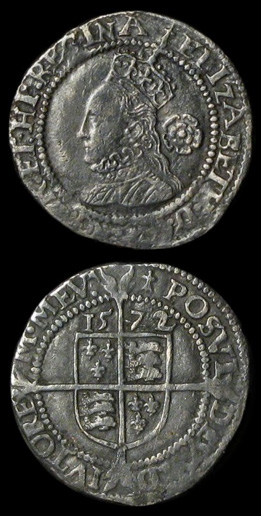Threepence
Share this page:
The first threepence appeared at the time of the fine silver coinage of Edward VI. Edward's earlier coinage had continued in the vein of the coin of Henry VII before him: Debased, and of poor quality. However with the fine silver issue, Edward not only made amends but introduced new denominations: The sixpence and threepence. The new threepence was easily identified by the Roman numeral "III" appearing next to the king's head on the obverse. However, despite being made of fine silver and of a convenient denomination (four to the shilling), the coin (like many other coins when introduced for the first time) was initially unpopular. [1]

Silver Threepence of Elizabeth I (1558-1603)
Obv: Tall bust, ear shows.
1572 ("2 over inverted 2"), mintmark: ermine.
Weight 1.50g (S. 2566, N.1998).
Image supplied by AMR Coins.
Elizabeth I Threepence
Elizabeth I (1558-1603) reintroduced the threepence, none having been minted by Mary / Mary and Philip (who had reverted to minting the groat or fourpence of previous times). Elizabeth's threepenny coins featured a rose behind the queen's portrait which assisted in distinguishing them from the groat and halfgroat, which were not too dissimilar in size. [2]
Elizabeth's moneyers also produced a milled threepence, as opposed to employing the traditional manufacturing technique of hammering. These new coins were evidently popular as a jewelry piece, as they are often found pierced or given a thin coating of gold. The coins were much thinner than modern coins, which often resulted in their being bent, which left a crease mark in the coin. [2]
Georgian Threepence
Silver threepences continued to be made by subsequent monarchs as currency coins until the time of George III (1760-1820). Prolific numbers of these small silver coins are known to have been minted in the earlier part of his reign and are typically found in fine (i.e. quite worn) condition. However the threepences of his latter reign (1817-1820), the first to be issued since 1800, are very often found in much higher grade, indicating that this coin was most likely used primarily for Maundy money and not for general circulation. [2] Some were also made and exported for colonial use. George III threepences were issued in 1762–3, 1765–6, 1770, 1772, 1780, 1784, 1786, 1792, 1795, 1800, 1817, 1818, and 1820. From the time of the Great Recoinage (1816) to 1945, the silver threepence weighed 1.4 grams and was 16mm in diameter.
Victoria Threepence
From 1817 until the time of Victoria (1837-1901), the silver threepence was used predominantly as a Maundy coin. Under Victoria, the coin was again produced with general currency in mind and during Victoria's reign, Maundy and currency threepences used an identical design. The threepences of Victoria are reported to be scarce and challenging to collect in the higher grades of condition. [1]
Threepence Reverse Design
The famous silver threepence reverse design with the large arabic numeral "3" was introduced during the coinage of William and Mary (1688-1694) and was continued all the way to 1926, when a reverse design of three interlocking acorns and oak leaves was used for standard currency coins. The Maundy coins however continued to use the traditional reverse design of the large number 3 and this has continued to current times.
Brass Threepence
The silver threepence had become unpopular as its small size meant that it was easily lost and fiddly to use. A chunky 12-sided brass threepence, much larger in size than the diminutive silver threepence, was introduced in 1937 and continued to be minted until 1970 and the advent of decimal coinage.
1945 Threepence
The silver threepence continued to be minted as a currency coin until 1945, coexistsing with the nickel brass threepence from 1937 onwards. The 1945 silver threepence is extremely rare and valuable, with only one or two said to have survived: Almost all of the c. 400,000 originally made were melted down.
The Maundy threepence has continued to the current day - and after 1947 was restored to the original standard of 925 silver.
Threepence Nicknames
The name of the threepence has been shortened in pronunciation in various ways, including "threppence", "thruppence" and "thruppny". The coin was also nicknamed the "ticky" in South Africa. [1]
Threepence - References:
[1] http://en.wikipedia.org/wiki/Threepence_(British_coin)
[2] Coincraft's Standard Catalogue of English and UK coins

Privacy Policy |
Cookie Policy |
GDPR

Disclaimer - While every care was taken in the preparation of this website (www.coinandbullionpages.com) and its contents, no guarantee is made as to the suitability of this website for any purpose whatsoever, nor of the accuracy, timeliness or usefulness of its information. This website is provided for general information and entertainment purposes only and the information provided on this web site should not be seen as, nor as a substitute for, legal, business or investment advice. The website's owner specifically disclaims any and all liability arising in conjunction with the use of the materials / information herein.


